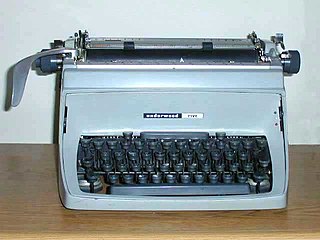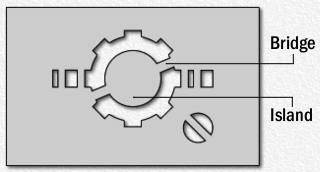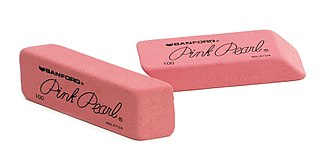Related Research Articles

A ballpoint pen, also known as a biro, ball pen, or dot pen (Nepali) is a pen that dispenses ink over a metal ball at its point, i.e. over a "ball point". The metal commonly used is steel, brass, or tungsten carbide. The design was conceived and developed as a cleaner and more reliable alternative to dip pens and fountain pens, and it is now the world's most-used writing instrument; millions are manufactured and sold daily. It has influenced art and graphic design and spawned an artwork genre.

Drawing is a form of visual art in which an artist uses instruments to mark paper or other two-dimensional surface. Drawing instruments include graphite pencils, pen and ink, various kinds of paints, inked brushes, colored pencils, crayons, charcoal, chalk, pastels, erasers, markers, styluses, and metals. Digital drawing is the act of drawing on graphics software in a computer. Common methods of digital drawing include a stylus or finger on a touchscreen device, stylus- or finger-to-touchpad, or in some cases, a mouse. There are many digital art programs and devices.

A mimeograph machine is a low-cost duplicating machine that works by forcing ink through a stencil onto paper. The process is called mimeography, and a copy made by the process is a mimeograph.

Printmaking is the process of creating artworks by printing, normally on paper, but also on fabric, wood, metal, and other surfaces. "Traditional printmaking" normally covers only the process of creating prints using a hand processed technique, rather than a photographic reproduction of a visual artwork which would be printed using an electronic machine ; however, there is some cross-over between traditional and digital printmaking, including risograph.

A typewriter is a mechanical or electromechanical machine for typing characters. Typically, a typewriter has an array of keys, and each one causes a different single character to be produced on paper by striking an inked ribbon selectively against the paper with a type element. At the end of the nineteenth century, the term 'typewriter' was also applied to a person who used such a device.

A drawing board is, in its antique form, a kind of multipurpose desk which can be used for any kind of drawing, writing or impromptu sketching on a large sheet of paper or for reading a large format book or other oversized document or for drafting precise technical illustrations. The drawing table used to be a frequent companion to a pedestal desk in a study or private library, during the pre-industrial and early industrial era.

A pen is a common writing instrument that applies ink to a surface, usually paper, for writing or drawing. Early pens such as reed pens, quill pens, dip pens and ruling pens held a small amount of ink on a nib or in a small void or cavity which had to be periodically recharged by dipping the tip of the pen into an inkwell. Today, such pens find only a small number of specialized uses, such as in illustration and calligraphy. Reed pens, quill pens and dip pens, which were used for writing, have been replaced by ballpoint pens, rollerball pens, fountain pens and felt or ceramic tip pens. Ruling pens, which were used for technical drawing and cartography, have been replaced by technical pens such as the Rapidograph. All of these modern pens contain internal ink reservoirs, such that they do not need to be dipped in ink while writing.

A stylus is a writing utensil or a small tool for some other form of marking or shaping, for example, in pottery. It can also be a computer accessory that is used to assist in navigating or providing more precision when using touchscreens. It usually refers to a narrow elongated staff, similar to a modern ballpoint pen. Many styluses are heavily curved to be held more easily. Another widely used writing tool is the stylus used by blind users in conjunction with the slate for punching out the dots in Braille.

Stencilling produces an image or pattern on a surface, by applying pigment to a surface through an intermediate object, with designed holes in the intermediate object. The holes allow the pigment to reach only some parts of the surface creating the design. The stencil is both the resulting image or pattern and the intermediate object; the context in which stencil is used makes clear which meaning is intended. In practice, the (object) stencil is usually a thin sheet of material, such as paper, plastic, wood or metal, with letters or a design cut from it, used to produce the letters or design on an underlying surface by applying pigment through the cut-out holes in the material.

A desk or bureau is a piece of furniture with a flat table-style work surface used in a school, office, home or the like for academic, professional or domestic activities such as reading, writing, or using equipment such as a computer. Desks often have one or more drawers, compartments, or pigeonholes to store items such as office supplies and papers. Desks are usually made of wood or metal, although materials such as glass are sometimes seen.

An eraser is an article of stationery that is used for removing marks from paper or skin. Erasers have a rubbery consistency and come in a variety of shapes, sizes and colors. Some pencils have an eraser on one end. Less expensive erasers are made from synthetic rubber and synthetic soy-based gum, but more expensive or specialized erasers are made from vinyl, plastic, or gum-like materials.

A penciller is an artist who works on the creation of comic books, graphic novels, and similar visual art forms, with a focus on the initial pencil illustrations, usually in collaboration with other artists, who provide inks, colors and lettering in the book, under the supervision of an editor.
A writing implement or writing instrument is an object used to produce writing. Writing consists of different figures, lines, and or forms. Most of these items can be also used for other functions such as painting, drawing and technical drawing, but writing instruments generally have the ordinary requirement to create a smooth, controllable line.

A technical pen is a specialized instrument used by an engineer, architect, or drafter to make lines of constant width for architectural, engineering, or technical drawings. "Rapidograph" is a trademarked name for one type of technical pen. Technical pens use either a refillable ink reservoir or a replaceable ink cartridge.

A kneaded eraser, also commonly known as a putty rubber, is a pliable erasing tool used by artists. It is usually made of a grey or white unvulcanized rubber resembling putty or chewing gum. It functions by absorbing and "picking up" graphite and charcoal particles, in addition to carbon, colored pencil, or pastel marks. It neither wears nor leaves residue, thereby lasting much longer than other erasers.

Drafting tools may be used for measurement and layout of drawings, or to improve the consistency and speed of creation of standard drawing elements. Tools such as pens and pencils mark the drawing medium. Other tools such as straight edges, assist the operator in drawing straight lines, or assist the operator in drawing complicated shapes repeatedly. Various scales and the protractor are used to measure the lengths of lines and angles, allowing accurate scale drawing to be carried out. The compass is used to draw arcs and circles. A drawing board was used to hold the drawing media in place; later boards included drafting machines that sped the layout of straight lines and angles. Tools such as templates and lettering guides assisted in the drawing of repetitive elements such as circles, ellipses, schematic symbols and text. Other auxiliary tools were used for special drawing purposes or for functions related to the preparation and revision of drawings. The tools used for manual technical drawing have been displaced by the advent of computer-aided drawing, drafting and design (CADD).
The following outline is provided as an overview of and typical guide to drawing and drawings:

The visual arts are art forms such as painting, drawing, printmaking, sculpture, ceramics, photography, video, filmmaking, design, crafts and architecture. Many artistic disciplines such as performing arts, conceptual art, and textile arts also involve aspects of visual arts as well as arts of other types. Also included within the visual arts are the applied arts such as industrial design, graphic design, fashion design, interior design and decorative art.

Erased de Kooning Drawing (1953) is an early work of American artist Robert Rauschenberg. This conceptual work presents an almost blank piece of paper in a gilded frame. It was created in 1953 when Rauschenberg erased a drawing he obtained from the Abstract Expressionist and American artist Willem de Kooning. Rauschenberg's friend and fellow artist, Jasper Johns, later framed it in a gilded frame and added a written caption to mimic the framing style of the Royal Academy and monogramming found on Renaissance drawings and prints. The caption reads: "Erased de Kooning Drawing, Robert Rauschenberg, 1953.” It has been in the collection of the San Francisco Museum of Modern Art (SFMOMA) since 1998. SFMOMA describes the work as a "drawing [with] traces of drawing media on paper with a label and gilded frame."

Artists' charcoal is charcoal used as a dry art medium. Both compressed charcoal and charcoal sticks are used. The marks it leaves behind on paper are much less permanent that with other media such as graphite, and so lines can easily be erased and blended. Charcoal can produce lines that are very light or intensely black. The dry medium can be applied to almost any surface from smooth to very coarse. Fixatives are used with charcoal drawings to solidify the position to prevent erasing or rubbing off of charcoal dusts.
References
- ↑ "Definition of ERASER SHIELD". Merriam-Webster Dictionary. Merriam-Webster, Incorporated. Retrieved 2023-04-06.
- 1 2 3 Hesson, Robert (28 March 2023). "Erasers, Erasing Shields, and Brushes for Drawing - Construction Drawings". Northern Architecture. Retrieved 2023-04-13.
- 1 2 3 4 Courtice, Becca (27 April 2021). "Little-Known Lettering Tool: Eraser Shield". The Happy Ever Crafter. Retrieved 2023-04-13.
- 1 2 "Eraser Shield". ToolNotes. Retrieved 2023-04-06.